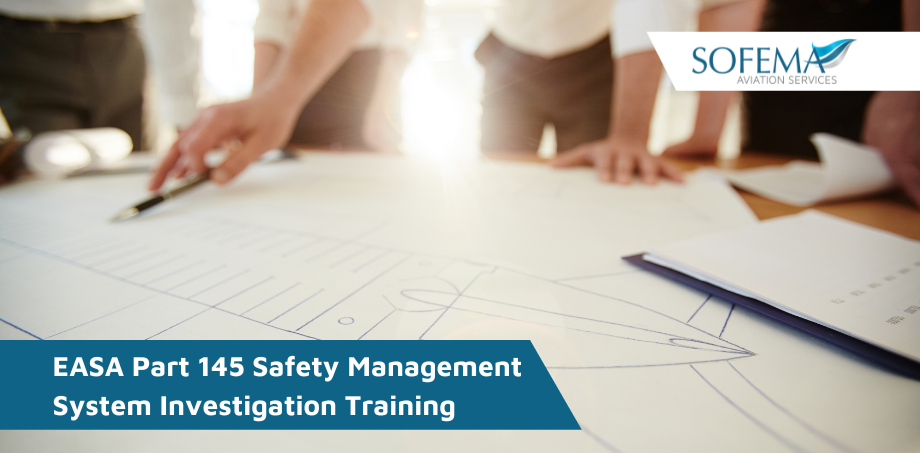EASA Part 145 Safety Management System Investigation Training – Introduction by Sofema Aviation Services (SAS) www.sassofia.com
Safety Investigation Training mandated as Part of the Introduction to EASA Part 145 Safety Management Key Processes ( Reference AMC1 145.A.200(a)(3) Management system) item c) Internal investigation:
(1) In line with its just culture policy, the organisation should define how to investigate incidents such as errors or near misses, in order to understand not only what happened, but also how it happened, to prevent or reduce the probability and/or consequence of future recurrences (refer to AMC1 145.A.202).
This approach should avoid concentrating the analysis on who was (were) directly or indirectly concerned by the events.
(2) The scope of internal investigations should extend beyond the scope of the occurrences required to be reported to the competent authority in accordance with point 145.A.60, to include the reports referred to in 145.A.202(b).
AMC1 145.A.202 Internal safety reporting scheme requires:
(3) a process to:
(i) identify those reports which require investigation; and
(ii) when so identified, investigate all the causal and contributing factors, including technical, organisational, managerial, or human factors issues, and any other contributing factors related to the occurrence, incident, error, or near miss that was identified;
(iii) if adapted to the size and complexity of the organisation, analyse the collective data showing the trends and frequencies of the contributing factors;
(4) appropriate corrective actions based on the findings of investigations;
(5) initial and recurrent training for staff involved in internal investigations;
The developments of an Internal safety reporting scheme have been strengthened with the introduction of a separate provision concerning ‘Internal Safety Reporting Scheme’ and the existing provisions have been further enhanced and complemented with specific AMC and GM.
The new provisions aim at the establishment of a confidential internal safety reporting scheme as part of the organisation’s ‘safety information system’ to help the organisation foster its safety culture.
This is important as a strong safety culture is an essential ingredient for effective safety management.
It is also important to note that the intent of the internal safety reporting scheme is not only to capture reactive safety information following from errors, near-misses, or other undesirable events (occurrences) but also to capture safety.
MEMS is based on the philosophy that errors result from a series of related “factors”.
Within maintenance practices, those “factors” typically include misleading or incorrect information, design issues, inadequate communication, and time pressure.
Boeing together with industry contribution developed the Maintenance Event Decision Aid (MEDA) process.
A variety of operators have witnessed substantial safety improvements, and some have also experienced significant economic benefits because of reduced maintenance errors.
A detailed understanding of the effectiveness of the MEMS system is built on the understanding that an Aviation Incident or accident is typically the culmination of a chain of events.
If we are able to remove one or more of the links then it may often be enough to actually prevent the error.
One of the biggest challenges the organization faces is to take control of its safety culture, this process is built on a foundation of trust and can be easily damaged by ineffective process management.
Developing a Proactive Focus
To fully deliver compliance with the provision of ICAO SARPS in particular annex 19, the system has to look beyond the reactive elements.
Means to capture safety hazards as well as to capture reactive safety information following from errors, near-misses or other undesirable events (occurrences).
If we can encourage people to report also “nearly” Incidents and accidents we can become proactive and avoid such in the first place.
A Maintenance Error Management System may be either stand alone process or become a component of your organizational SMS.
Typically an integrated process whereby the MEMS is embedded in terms of both culture and process will deliver the most positive outcomes.
Typically the knowledge and competency required to work within the MEMS environment should be found in both the Quality Department and Maintenance Management Departments.
Effective MEMS should aim to deliver positive changes based on the implementation of the HF principles which we consider during our initial and recurrent training, which are then applied in a real and tangible way with the workplace environment.
A starting point when building your organisations MEMS system is to
a) Acquire a detailed understanding of Maintenance Events (Errors)
b) Why they happen?
c) What we have to do to be able to manage our maintenance processes and
d) How to implement “Positive Change”
e) Finally how to enable an “OPEN” reporting culture.
Next Steps
Follow this link to our Library to find & Download related documents for Free.
Sofema Aviation Services & Sofema Online provide Safety Management System , Human Factors and Maintenance Error Management System Training as Classroom, Webinar & Online training. For more information, please visit our websites or email team@sassofia.com
Tags:
aviation, EASA Part 145, Human Factors, Part 145, Sofema Aviation Serives, SMS, Safety Risk, Incident Investigations, Aviation SMS, Human Performance, SAS blogs, Internal investigations, Safety Management Systems (SMS), Aviation Safety Management Systems





